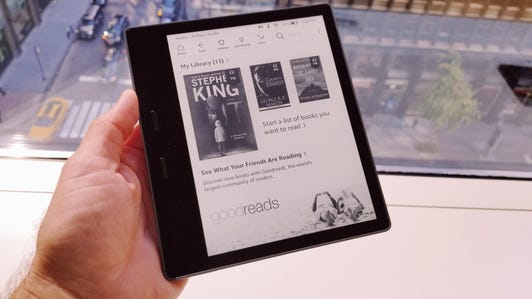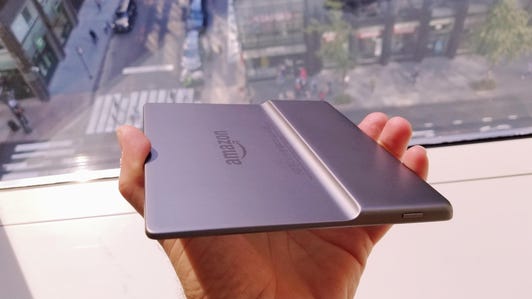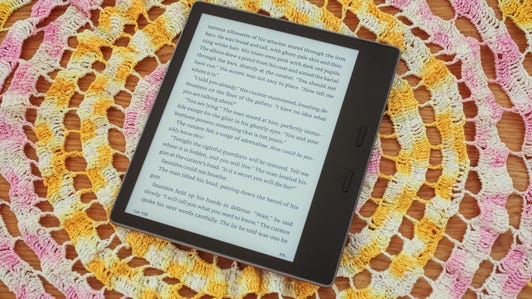In early 2005, Charlie Tritschler, an Apple veteran, walked into an old law library in Palo Alto, California, where a small group of Amazon employees was working on a secret project and looking to bring him onboard. The space included floor-to-ceiling book stacks and the team worked at boxy carrel desks. But, incongruous to the setting, a table nearby held a mess of computer guts including an e-ink panel and a development board.
That jumble of electronic parts was a very early prototype of what would eventually become the Kindle e-reader, Amazon’s first consumer device. The team of seven employees needed somebody, hopefully Tritschler, to take on product management.
“I caught the bug almost immediately,” he said.


Now playing:
Watch this:
Amazon Kindle
2:03
This month, the Kindle reached its 10-year anniversary. To mark the occasion, Tritschler and David Naggar, vice president of Kindle content, spoke to CNET about two of the Kindle’s biggest — and first — innovations: The hardware itself and the self-publishing platform Kindle Direct Publishing.
Maybe you haven’t used a Kindle in a while or maybe you’re a diehard Kindle reader. Regardless, the device itself became a big deal. While it wasn’t the first e-reader out there, it helped usher in e-books after several other failed attempts to popularize the format. It kicked off Amazon’s big expansion into consumer devices, with the e-commerce company now offering its own line of tablets, TV streamers and smart speakers. And — much to the chagrin of some publishers — it helped Amazon gain an even tighter grip on the book world.
It didn’t, however, kill off printed books — a fear held for years following the Kindle’s launch. On the contrary, hardcovers and paperbacks still account for most book sales.
Amazon is now the undisputed leader in e-readers, holding 60 percent of worldwide device sales this year, according to Euromonitor. But, the future of e-readers is less rosy: total sales, which include Rakuten’s Kobo and Barnes & Nobles’ Nook, have been shrinking for six years running, Euromonitor said. For many customers, tablets have replaced e-readers, and phones in turn have replaced tablets.
Amazon Kindle 2 slideshow






+16 more
Bucking that trend, Amazon said its global Kindle sales are up globally since last year and this year’s Prime Day was the single biggest day of Kindle sales ever.
“The strength of Amazon is they know who are buying them,” Mikako Kitagawa, a Gartner analyst covering consumer devices, adding that the company can use Amazon account data to respond to customers’ interests faster than competitors. “As long as Amazon thinks it’s profitable, they are going to make it.”
Books via free wireless
Tritschler, who worked as a product manager for Apple’s PowerBook line, was invited to visit the law library by Gregg Zehr, a former colleague from Apple who was heading Amazon’s new hardware skunkworks called Lab126. The team was using office space it borrowed from A9, Amazon’s search subsidiary, which took over an old law firm office in Palo Alto.
“It was a pretty small, intimate kind of startup inside a big company environment,” Tritschler said.
The team set a lofty goal for themselves. While e-readers at the time required you to connect to your computer to download new books, Amazon sought to offer a ubiquitous, wireless connection to download new content on the go.
“We created that rallying cry of any book from anywhere in the world in 60 seconds or less,” Tritschler said. “Which the first time we wrote that down it was like, ‘Gulp!'”


Now playing:
Watch this:
The new Amazon Kindle
1:55
Amazon CEO and founder Jeff Bezos was heavily involved in the process and challenged the team to find a way to create that wireless connection, insisting it’s what customers wanted. They pulled off the feat by adding into the device a phone modem, jury-rigging the chip for downloads instead of voice calls. They partnered with Sprint, which provided the wholesale cell service.
As the Lab126 team prepared to launch the new device, they joined Bezos for a two-day offsite meeting. Bezos, currently the richest person in the world but also a fan of frugality, invite the team to his parents’ house in the Seattle area while his parents were on vacation in Italy, Tritschler said.
Ten years later, Tritschler said tens of thousands of people still use the original Kindle device.
“I smile everytime I see one on a plane,” Tritschler said.
Ten years ago today, we launched the first-ever Kindle. Happy 10th birthday @AmazonKindle and thank you to all the Kindle readers and authors! pic.twitter.com/qelfniBSK1
— Jeff Bezos (@JeffBezos) November 19, 2017
A book publisher for all
In tandem with the Kindle’s launch, Amazon introduced Kindle Direct Publishing. The concept of self-publishing already existed, via some printers or on a blog, but KDP simplified the process and gave authors a new route to reach millions of readers.
“It just grew the options for people who were telling stories and, as a result, it grew the options for people who want to read stories,” said Naggar, who spent 20 years in the book business before joining Amazon in 2009.
As KDP grew in popularity, he helped build out the platform from its rudimentary beginnings. Amazon added a book cover creator, the Kindle Unlimited subscription service, and more publishing, pricing and layout tools. The platform helped hundreds of thousands of authors get published.
Some of the most notable names that have risen from that group include “The Martian” author Andy Weir, “Fifty Shades of Grey” author E. L. James and “Wool” author Hugh Howey, though their experiences are far from typical.
Amazon Kindle Oasis (2017) pictures






+28 more
The rise of self-publishing — with Apple, Barnes & Noble and others now providing similar platforms — hasn’t been free of controversy. Some have complained that self-publishing has resulted in a flood of low-quality titles that wouldn’t have passed muster with a publisher, as well as an excess of selection.
Naggar disagreed with both arguments, noting that traditional publishers already offer a mountain of selection by coming out with tens of thousands of titles a year. And Amazon’s ratings and reviews system, in addition to its Goodreads site, helps weed out the lousy books and highlights the good ones, he said.
“Readers don’t care who published it, so if it’s a good book, it’s going to sell,” Naggar added. “The notion that allowing self-publishing somehow creates worse books, I don’t buy it, because customers don’t buy bad books. Now more than ever.”
Black Friday deals: See every Black Friday 2017 deal we’ve found so far
Holiday Gift Guide: CNET’s full gift guide, including dozens of products priced under $25, $50 and $100



